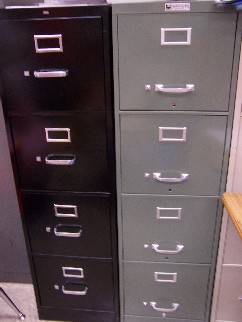Filing cabinet
Filing cabinet is a piece of office furniture used to store paper documents in file folders. The primary function of a filing cabinet is to organize documents in a way that makes them easily accessible while protecting them from damage. Filing cabinets are an essential component of office organization, particularly in environments where paper documents are frequently used, such as in law offices, medical practices, and business offices.
Types of Filing Cabinets[edit | edit source]
There are several types of filing cabinets, each designed to meet different needs and space considerations:
- Vertical filing cabinets: These cabinets have drawers that extend from the short side of the cabinet. They are traditionally used and are suitable for offices with limited space since they take up less wall space.
- Lateral filing cabinets: These have drawers that extend from the long side of the cabinet. They can hold more files than vertical cabinets and are easier to access without reaching deep into the cabinet. Lateral filing cabinets are ideal for larger offices with more space.
- Mobile filing cabinets: These are compact and equipped with wheels, making them easy to move around. They are suitable for home offices or spaces where flexibility is required.
- Fireproof filing cabinets: Designed to protect documents from fire damage, these cabinets are built with special materials that can withstand high temperatures.
Materials[edit | edit source]
Filing cabinets are made from a variety of materials, including metal, wood, and plastic. Metal filing cabinets, typically made of steel, are the most durable and are commonly used in professional office settings. Wood filing cabinets offer an aesthetic appeal and are often found in home offices or environments where decor is a consideration. Plastic filing cabinets are lightweight and cost-effective, suitable for temporary or light-duty storage needs.
Features[edit | edit source]
Modern filing cabinets come with a range of features designed to enhance security, accessibility, and efficiency. These features may include:
- Locking mechanisms to secure sensitive documents.
- Suspension files that hang from the rails of the drawers for easy access and organization.
- Anti-tilt devices that prevent more than one drawer from being opened at a time, reducing the risk of the cabinet tipping over.
- Label holders that allow for easy identification of contents.
Choosing a Filing Cabinet[edit | edit source]
When selecting a filing cabinet, consider the following factors:
- Size and capacity: Assess the volume of documents to be stored and the available office space to determine the appropriate size and type of cabinet.
- Security needs: For sensitive or confidential documents, choose a cabinet with a reliable locking mechanism.
- Material and durability: Consider the expected usage and the office environment to select a material that offers the right balance of durability and aesthetics.
- Budget: Filing cabinets vary in price based on size, material, and features. Determine a budget that reflects the importance of document storage in your office setting.
Conclusion[edit | edit source]
Filing cabinets play a crucial role in maintaining an organized and efficient office environment. By carefully selecting the right type, size, and features of a filing cabinet, businesses and individuals can ensure that their documents are stored securely and are easily accessible when needed.
Search WikiMD
Ad.Tired of being Overweight? Try W8MD's physician weight loss program.
Semaglutide (Ozempic / Wegovy and Tirzepatide (Mounjaro / Zepbound) available.
Advertise on WikiMD
|
WikiMD's Wellness Encyclopedia |
| Let Food Be Thy Medicine Medicine Thy Food - Hippocrates |
Translate this page: - East Asian
中文,
日本,
한국어,
South Asian
हिन्दी,
தமிழ்,
తెలుగు,
Urdu,
ಕನ್ನಡ,
Southeast Asian
Indonesian,
Vietnamese,
Thai,
မြန်မာဘာသာ,
বাংলা
European
español,
Deutsch,
français,
Greek,
português do Brasil,
polski,
română,
русский,
Nederlands,
norsk,
svenska,
suomi,
Italian
Middle Eastern & African
عربى,
Turkish,
Persian,
Hebrew,
Afrikaans,
isiZulu,
Kiswahili,
Other
Bulgarian,
Hungarian,
Czech,
Swedish,
മലയാളം,
मराठी,
ਪੰਜਾਬੀ,
ગુજરાતી,
Portuguese,
Ukrainian
Medical Disclaimer: WikiMD is not a substitute for professional medical advice. The information on WikiMD is provided as an information resource only, may be incorrect, outdated or misleading, and is not to be used or relied on for any diagnostic or treatment purposes. Please consult your health care provider before making any healthcare decisions or for guidance about a specific medical condition. WikiMD expressly disclaims responsibility, and shall have no liability, for any damages, loss, injury, or liability whatsoever suffered as a result of your reliance on the information contained in this site. By visiting this site you agree to the foregoing terms and conditions, which may from time to time be changed or supplemented by WikiMD. If you do not agree to the foregoing terms and conditions, you should not enter or use this site. See full disclaimer.
Credits:Most images are courtesy of Wikimedia commons, and templates, categories Wikipedia, licensed under CC BY SA or similar.
Contributors: Prab R. Tumpati, MD





